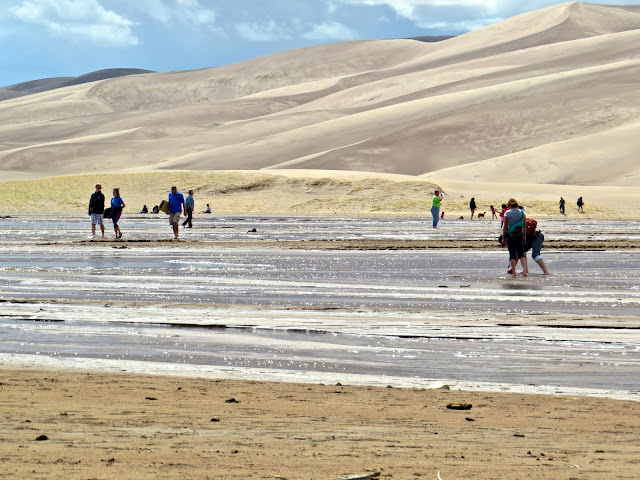Great Sand Dunes is another
National Park “off the beaten path”.
Located in south-central Colorado, away from major populations, it is
definitely a destination spot (i.e., you have to want to go there).
We had made camping
reservations at San Luis Lake SP, about 10 miles from the sand dunes. Like other CO state parks we stayed in this
trip, San Luis had large sites and views all around us. The sand dunes are so large we could see them
from our campsite – with the Sangre de Cristo Mountains in the background.
It’s in a rather high desert
area (no trees), and, unfortunately its lake was almost dry. There also was no water at the camp sites; we
were prepared with our tank filled. The
camp hosts were great and mentioned the frequent winds in the area; we learned
more about these winds and their relationship to the sand dunes during our
visit at the NP.
After setting up the RV and
walking the dogs, we headed to the NP Visitors Center to get some information
on WHY these dunes are here.
These dunes (the highest in
North America) rise up to 750 feet above the surrounding lands and cover about
11% of the total of 330 square miles of sand deposits. The prevailing winds from the southwest have
brought most of the sand from the San Juan Mountains (65 miles away). Of
course, this all started many years ago – estimates put the dunes over 400,000
years old.
 |
| Grasslands/desert, water, dunes and mountains |
However, the sands are not
found in a large, sand-covered desert.
The dunes back up to the Sangre de Cristo Mts and the park includes many
eco-systems. Streams (Medano and Sand Creek)
flowing from snow melts and rains, go around the dunes carrying the sands towards the
open valley beyond. Then the prevailing winds take sands back to the dunes in a
continual cycle.
While we were there,
hundreds of visitors were enjoying the cold Medano stream and climbing the dune
“peaks”. All said the waters were cold
and the climbs strenuous in the sands.
We chose some hiking along
the bases of the mountains, with trailheads located just a few hundred yards
from the dunes! The weather was perfect
for viewing the dunes and traveling along areas where early European settlers
had tried their luck mining and ranching.
Remnants of the old wagon road were the only remains seen of these early
sites.
We also found mule deer out for their morning forage. They seemed very accustomed to humans nearby, but kept alert as we moved slowly on down the trail.
One of the trailheads began
at the campground, which gave us a chance to check it out. Being Memorial Day weekend, sites were filled
with a mix of tents and smaller trailers and RVs. It would have been difficult/impossible to
find spaces for big rigs.
 |
| Large mass colonies of small prickly pear cacti growing along trail |
Due to recent rains, a stream along the trail was running wide and deep - we had to ford it with no rocks or logs to use for a bridge.
 |
| Leslie jumping over creek on trail |
We really enjoyed our brief
visit to Great Sand Dunes NP. The
rangers were super - friendly and knowledgeable. This former National Monument was established
as a National Park and Preserve in 2004, to protect the entire geologic and
hydrologic system of the dunes.













We were there in the fall and the creek was bone dry. Looks strange to see all that water.
ReplyDeleteToo bad you didn't get to meet Box Canyon Mark and Bobbie when you went to Ouray. They are very nice folks.
The water was really running through the canyon. I looked for a tall guy with shorts and snowshoes but didn't see him. I felt we know a lot about Ouray because of the BCB.
Delete